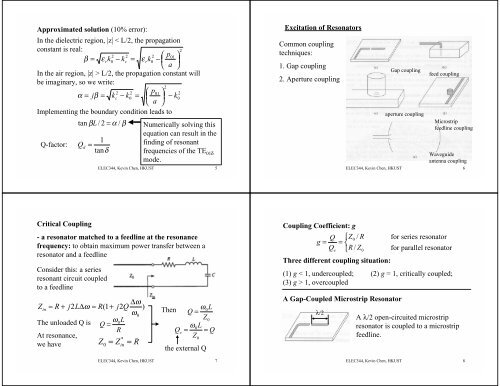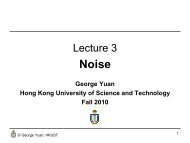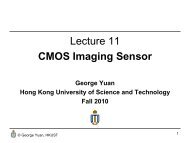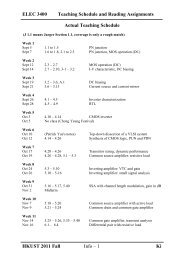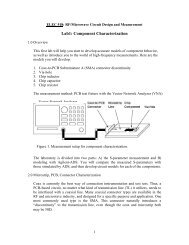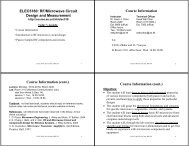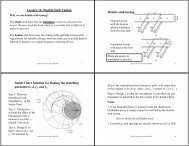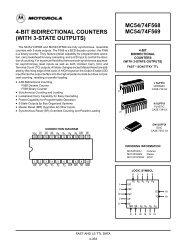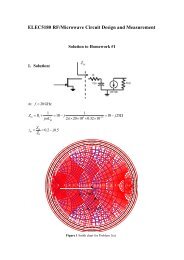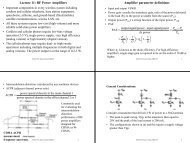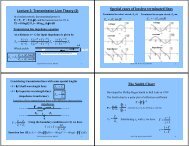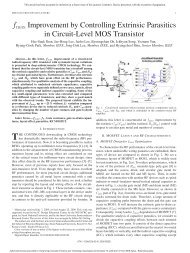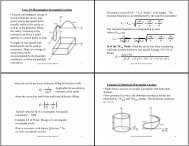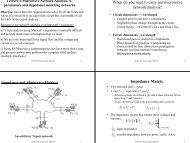Lect. 20: Dielectric Resonators & Excitation of Resonators ⢠Made of ...
Lect. 20: Dielectric Resonators & Excitation of Resonators ⢠Made of ...
Lect. 20: Dielectric Resonators & Excitation of Resonators ⢠Made of ...
You also want an ePaper? Increase the reach of your titles
YUMPU automatically turns print PDFs into web optimized ePapers that Google loves.
Approximated solution (10% error):<br />
In the dielectric region, |z| < L/2, the propagation<br />
constant is real:<br />
2<br />
2 2<br />
2 ⎛ p01<br />
⎞<br />
β = ε r<br />
k0 − kc<br />
= ε<br />
rk0<br />
− ⎜ ⎟<br />
⎝ a ⎠<br />
In the air region, |z| > L/2, the propagation constant will<br />
be imaginary, so we write:<br />
2<br />
2 2 ⎛ p01<br />
⎞ 2<br />
α = jβ<br />
= kc − k0<br />
= ⎜ ⎟ − k0<br />
⎝ a ⎠<br />
Implementing the boundary condition leads to<br />
Q-factor:<br />
tan β L / 2 = α / β<br />
Q d<br />
=<br />
1<br />
tanδ<br />
Numerically solving this<br />
equation can result in the<br />
finding <strong>of</strong> resonant<br />
frequencies <strong>of</strong> the TE 01δ<br />
mode.<br />
ELEC344, Kevin Chen, HKUST 5<br />
<strong>Excitation</strong> <strong>of</strong> <strong>Resonators</strong><br />
Common coupling<br />
techniques:<br />
1. Gap coupling<br />
2. Aperture coupling<br />
Gap coupling<br />
aperture coupling<br />
feed coupling<br />
Microstrip<br />
feedline coupling<br />
Waveguide<br />
antenna coupling<br />
ELEC344, Kevin Chen, HKUST 6<br />
Critical Coupling<br />
- a resonator matched to a feedline at the resonance<br />
frequency: to obtain maximum power transfer between a<br />
resonator and a feedline<br />
Consider this: a series<br />
resonant circuit coupled<br />
to a feedline<br />
Z in<br />
≈ R + j2L∆ω<br />
≈ R(1<br />
+<br />
The unloaded Q is<br />
At resonance,<br />
we have<br />
ω0 Q =<br />
L<br />
R<br />
Z = Z<br />
* = in<br />
R<br />
0<br />
∆ω<br />
j2Q<br />
)<br />
ω 0<br />
Then<br />
0L<br />
Q =<br />
ω<br />
Z0<br />
ω L<br />
Q e<br />
= 0<br />
= Q<br />
Z<br />
ELEC344, Kevin Chen, HKUST 7<br />
0<br />
the external Q<br />
Coupling Coefficient: g<br />
Q ⎧Z0<br />
/ R for series resonator<br />
g = = ⎨<br />
Qe<br />
⎩R<br />
/ Z0<br />
for parallel resonator<br />
Three different coupling situation:<br />
(1) g < 1, undercoupled; (2) g = 1, critically coupled;<br />
(3) g > 1, overcoupled<br />
A Gap-Coupled Microstrip Resonator<br />
λ/2<br />
A λ/2 open-circuited microstrip<br />
resonator is coupled to a microstrip<br />
feedline.<br />
ELEC344, Kevin Chen, HKUST 8


